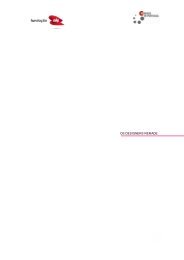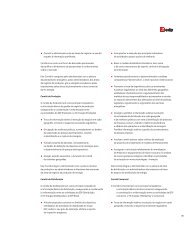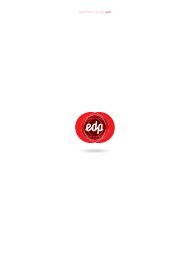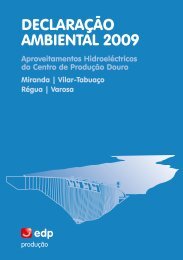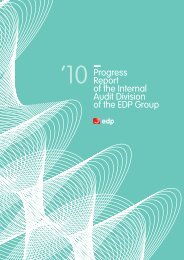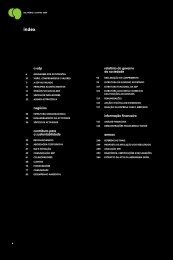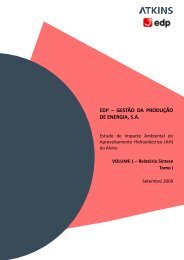Annual Report - EDP
Annual Report - EDP
Annual Report - EDP
- No tags were found...
You also want an ePaper? Increase the reach of your titles
YUMPU automatically turns print PDFs into web optimized ePapers that Google loves.
notes to the <strong>EDP</strong> consolidated - Energias de Portugal, and company S.A. financial statementsNotes to for the the Consolidated years and ended Company 31 december Financial Statements 2012 and 2011for the years ended 31 December 2012 and 2011Subsequent measurementAfter initial recognition, financial assets at fair value through profit or loss are subsequently carried at fair value, being the gains or losses arising from changes in theirfair value recorded in the income statement.Available-for-sale investments are also subsequently carried at fair value, however, gains and losses arising from changes in their fair value are recognised in fairvalue reserves until the financial assets are derecognised or impaired, being the cumulative gains or losses previously recognised in fair value reserves recognised inthe income statement. Foreign exchange differences relating to these assets are also recognised in fair value reserves if arising from shares, and in the incomestatement if arising from debt instruments. Interest, calculated using the effective interest rate method, as well as dividends received are recognised in the incomestatement.The fair value of listed investments in active markets is based on current bid price. The Group determines the fair value of unlisted securities through (i) valuationmethodologies, such as the price of similar recent arm’s length transactions and discounted cash flow techniques, and (ii) valuation assumptions based on marketinformation.Financial assets whose fair value cannot be reliably measured are stated at cost, being any impairment loss booked against the income statement.Reclassifications between categoriesThe Group does not transfer financial instruments into or out of the fair value through profit or loss category at the moment of its initial recognition being the variationsrecognised in the income statement (fair value option).ImpairmentAt each balance sheet date an assessment is performed as to whether there is objective evidence of impairment, namely those resulting in an adverse effect onestimated future cash flows of the financial asset or group of financial assets, and every time it can be reliably measured.If there is objective evidence of impairment, the recoverable amount of the financial asset is determined, and the impairment loss is recognised in the incomestatement.A financial asset or a group of financial assets is impaired if there is objective evidence of impairment as a result of one or more events that occurred after their initialrecognition, such as: (i) in the case of listed securities, a significant or prolonged decline in the listed price of the security, and (ii) in the case of unlisted securities, whenthat event (or events) has an impact on the estimated amount of the future cash flows of the financial asset or group of financial assets, that can be reliably estimated.If there is objective evidence of impairment on available-for-sale investments, the cumulative potential loss recognised in fair values reserves, corresponding to thedifference between the acquisition cost and the fair value at the balance sheet date, less any impairment loss on that financial asset previously recognised in theincome statement, is transferred to the income statement.For debt instruments, if in a subsequent period the amount of the impairment loss decreases, the previously recognised impairment loss is reversed to the incomestatement up to the amount of the acquisition cost, if the increase is objectively related to an event occurring after the impairment loss was recognised. In the case ofequity instruments, impairment losses can not be reversed and any subsequent event wich determines a fair value increase is recognised in equity under fair valuereserves.f) Financial liabilitiesAn instrument is classified as a financial liability when it contains a contractual obligation to liquidate capital and/or interests, through delivering cash or other financialasset, independently of its legal form. Financial liabilities are recognised (i) initially at fair value less transaction costs and (ii) subsequently at amortised cost, using theeffective interest method; or at fair value, whenever the Group chooses, on initial recognition, to designate such instruments as at fair value through profit or loss usingthe fair value option.g) Equity instrumentsA financial instrument is classified as an equity instrument when there is no contractual obligation at settlement to deliver cash or other financial asset to anotherentity, independently of its legal form, and there is a residual interest in the assets of an entity after deducting all its liabilities.Costs directly attributable to the issuance of equity instruments are recognised in equity, as a deduction to the amount issued. Amounts paid or received relating tosales or acquisitions of equity instruments are recognised in equity, net of transaction costs.Distributions related to equity instruments are deducted from equity, as dividends, when declared.Preference shares issued by the Group are considered as an equity instrument when the Group has no contractual obligation to redeem the shares and dividendsare paid at the discretion of the Group. Preference shares issued by subsidiaries, classified as equity instruments and held by third parties, are included under noncontrollinginterest.h) Property, plant and equipmentItems of Property, plant and equipment are stated at acquisition cost less accumulated depreciation and impairment losses. On transition to IFRS, on 1 January 2004,the Group decided to consider as deemed cost the revalued amount of Property, plant and equipment in accordance with the Group's previous accounting policy,which was comparable in general terms to the depreciated cost determined in accordance with IFRS.Subsequent costs are recognised as property, plant and equipment only when it is probable that future economic benefits associated with the item will flow to theGroup. Repair and maintenance costs are charged to the income statement as incurred, according to the accrual principle.<strong>EDP</strong> - <strong>Annual</strong> <strong>Report</strong> 2012181







